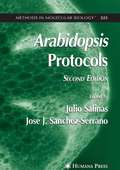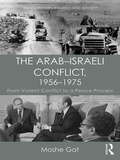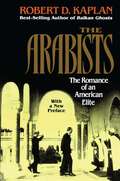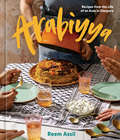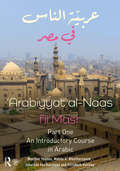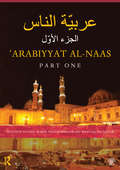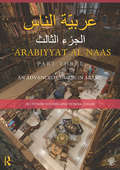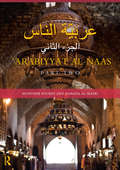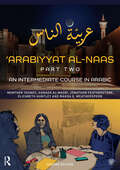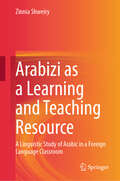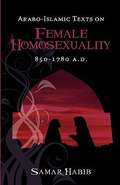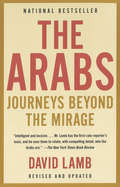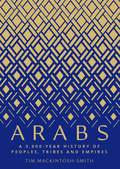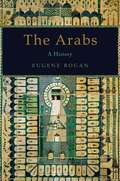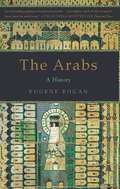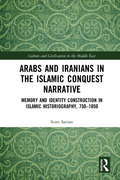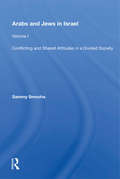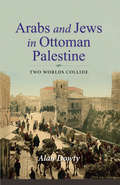- Table View
- List View
Arabidopsis Protocols, 2nd Edition (Methods in Molecular Biology #323)
by Julio Salinas Jose J. Sanchez-SerranoThis collection of readily reproducible Arabidopsis protocols has been updated to reflect recent advances in plant biology, the completion of the Arabidopsis genome sequence, which is essential for studying plant function, and the development of whole systems approaches that allow global analysis of gene expression and protein and metabolite dynamics. The authors have included nearly all techniques developed in Arabidopsis, others recently adapted from the traditional work in crop species, and the most recent ones using Arabidopsis as a model system. Highlights include the most recent methods-transcriptomics, proteomics, and metabolomics - and their novel applications (phosphoproteomics, DNA microarray-based genotyping, high throughput metabolite profiling, and single-cell RNA).
The Arab–Israeli Conflict, 1956–1975: From Violent Conflict to a Peace Process (Israeli History, Politics and Society)
by Moshe GatThe Arab–Israeli Conflict, 1956–1975 contains a collection of articles that examine select issues between the end of the Suez Campaign in November 1956 and the Sinai II, or Interim Agreement, signed by Israel and Egypt in September 1975. The book provides a comprehensive overview of the struggle between the three superpowers – the UK, the United States and the Soviet Union – and the effects this had on the region. It also explores the circumstances that led to the Six Day War in June 1967, such as the use of air power and the Israeli retaliatory raids. Two chapters look at the two leaders during the war: Egyptian President Gamal Abdel Nasser, leader of the Arab world – a charismatic and dominant persona – and Israeli Prime Minister Levi Eshkol, considered weak and inconspicuous. Three chapters focus on the period between the two wars – June 1967 and October 1973 – and one explores the aftermath. Emphasis is placed on Israeli policy between 1967 and 1973, which primarily focused on the use of military power and foreign policy inaction. It is argued that it was this policy that hindered all progress in the peace process, and ultimately led, among other factors, to the Yom Kippur War. The final chapter is on Kissinger and the road to the Sinai II Agreement. It discusses the huge shift in American policy – from avoiding a significant role in the prevention of an imminent war during May and June of 1967, to deep involvement in every detail of the dispute during and following the Yom Kippur War. Providing an in-depth examination of this important period of the Arab–Israeli conflict, this book will appeal to students and scholars of Middle Eastern History and Politics, Conflict Studies and International Relations.
Arabists: The Romance of an American Elite
by Robert D. KaplanA tight-knit group closely linked by intermarriage as well as class and old school ties, the “Arabists” were men and women who spent much of their lives living and working in the Arab world as diplomats, military attaches, intelligence agents, scholar-adventurers, and teachers. As such, the Arabists exerted considerable influence both as career diplomats and as bureaucrats within the State Department from the early nineteenth century to the present. But over time, as this work shows, the group increasingly lost touch with a rapidly changing American society, growing both more insular and headstrong and showing a marked tendency to assert the Arab point of view. Drawing on interviews, memoirs, and other official and private sources, Kaplan reconstructs the 100-year history of the Arabist elite, demonstrating their profound influence on American attitudes toward the Middle East, and tracing their decline as an influx of ethnic and regional specialists has transformed the State Department and challenged the power of the old elite.
Arabiyya: Recipes from the Life of an Arab in Diaspora [A Cookbook]
by Reem AssilA collection of 100+ bright, bold recipes influenced by the vibrant flavors and convivial culture of the Arab world, filled with moving personal essays on food, family, and identity and mixed with a pinch of California cool, from chef and activist Reem Assil &“This is what a cookbook should be: passion, politics, and personality are woven through the fabulous recipes.&”—Ruth Reichl, author of Save Me the PlumsONE OF FOOD52&’S MOST ANTICIPATED COOKBOOKS OF 2022Arabiyya celebrates the alluring aromas and flavors of Arab food and the welcoming spirit with which they are shared. Written from her point of view as an Arab in diaspora, Reem takes readers on a journey through her Palestinian and Syrian roots, showing how her heritage has inspired her recipes for flatbreads, dips, snacks, platters to share, and more. With a section specializing in breads of the Arab bakery, plus recipes for favorites such as Salatet Fattoush, Falafel Mahshi, Mujaddarra, and Hummus Bil Awarma, Arabiyya showcases the origins and evolution of Arab cuisine and opens up a whole new world of flavor. Alongside the tempting recipes, Reem shares stories of the power of Arab communities to turn hardship into brilliant, nourishing meals and any occasion into a celebratory feast. Reem then translates this spirit into her own work in California, creating restaurants that define hospitality at all levels. Yes, there are tender lamb dishes, piles of fresh breads, and perfectly cooked rice, but there is also food for thought about what it takes to create a more equitable society, where workers and people often at the margins are brought to the center. Reem's glorious dishes draw in readers and customers, but it is her infectious warmth that keeps them at the table. With gorgeous photography, original artwork, and transporting writing, Reem helps readers better understand the Arab diaspora and its global influence on food and culture. She then invites everyone to sit at a table where all are welcome.
Arabiyyat al-Naas fii MaSr (Part One): An Introductory Course in Arabic
by Munther Younes Makda Weatherspoon Elizabeth Huntley Jonathan Featherstone‘Arabiyyat al-Naas fii MaSr (Part One) offers a ground-breaking introduction to Arabic as it is written and spoken by native speakers. It combines a progressive and rigorous grounding in Modern Standard Arabic (MSA), the register employed for reading, writing and formal speaking, with an innovative integration of the dominant Egyptian variety. Introducing the two simultaneously and seamlessly building on their shared features, ‘Arabiyyat al-Naas fii MaSr (Part One) uses each in its proper context: Egyptian dialect for conversations and MSA for reading and writing activities. In this way, the course efficiently prepares students for the practical realities of learning and living Arabic today. Features include: Expanded grammar explanations and activation drills, including discussions about colloquial and formal similarities and differences A series of authentic video-clips recorded in Egypt to help learners revise the vocabulary and structures then learn unit by unit Extensive classroom activities and homework exercises that provide constant review to reinforce learning Arabic-English and English-Arabic glossaries, reference charts, and a grammar index Songs with simple lyrics tied to the themes of the course to help advance vocabulary acquisition and understanding of basic grammatical structures A companion website (www.routledge.com/cw/weatherspoon) that features fully integrated interactive, self-correcting exercises, audio and video materials, and additional online course management and grading options for teachers A user-friendly and vibrant text design with full colour, richly illustrated throughout with over two hundred illustrations and photos A teachers manual with an Arabic introduction for the teacher, which lays out the structure of the student course book, its methodology and directions and suggestions for its use. Written by experienced teachers of Arabic and experts in Arabic teaching pedagogy, ‘Arabiyyat al-Naas fii MaSr (Part One) is an essential resource for students beginning to learn Arabic.
Arabiyyat al-Naas (Part One): An Introductory Course in Arabic
by Maha Saliba Foster Makda Weatherspoon Munther Younes‘Arabiyyat al-Naas (Part One) offers a groundbreaking introduction to Arabic as it is written and spoken by native speakers. It combines a progressive and rigorous grounding in Modern Standard Arabic (MSA) – the form employed for reading, writing and formal speaking – with an innovative integration of the spoken Levantine variety used in everyday situations in Syria, Lebanon, Jordan and Palestine. Introducing the two simultaneously ‘Arabiyyat al Naas (Part One) uses each in its proper context: Levantine for conversations and MSA for reading and writing activities. In this way, the course efficiently prepares students for the practical realities of learning and "living" Arabic today. Features include: 21 theme-based units covering all the core topics expected in a first-year Arabic course, such as countries, clothes, colors, family and professions a broad range of stimulating activities and exercises fostering active engagement with the course and the development of comprehension and communication skills comprehensively covers the 5 Cs: communication, culture, connections, comparisons and communities a free DVD filmed on location in Jordan, presenting over 40 videos and incorporating a wide variety of entertaining and realistic scenarios a free companion website (www.routledge.com/cw/younes) offering a wealth of additional instructor and student resources, including a teacher’s guide, an introduction to the letters and sounds of Arabic (with audiovisual aid and writing demonstrations), audio recordings of songs and listening passages, video clips, sample tests, an answer key and language games clear explanations of grammatical structures and concepts as they occur in the reading and listening materials to encourage progressive learning and active interaction with the text a user-friendly and vibrant full colour text design, richly illustrated throughout with over 200 illustrations and photographs songs with simple lyrics tied to the themes of the course to help advance vocabulary acquisition and understanding of basic grammatical structures. Written by a dynamic author team and tested over a number of years at Cornell University, ‘Arabiyyat al-Naas (Part One) will be an essential resource for students beginning to learn Arabic. While primarily designed for classroom use, the accessibility of the course and website also renders it highly suitable for independent study. This volume is the first in an exciting three-part series of Arabic textbooks which together provide a complete three-year undergraduate language program.
Arabiyyat al-Naas (Part Three): An Advanced Course in Arabic
by Munther Younes Yomna Chami‘Arabiyyat al-Naas (Part Three): An Advanced Course in Arabic builds further on the groundbreaking approach used in Part One and Part Two of the series. It integrates Modern Standard Arabic (MSA) and spoken Levantine in a way specially tailored to the needs of advanced students. Levantine Arabic strongly features in spoken discussions of MSA materials, reflecting authentic practice by native speakers. However, the overall ratio of MSA – the form employed for reading, writing and formal speaking in the Arab world – to Levantine has been increased, supporting students’ mounting need for MSA as they progress further in their education. This textbook is designed to take learners from the Advanced Low to the Advanced High level according to the ACTFL criteria, and from level B2 to C1 on the CEFR proficiency scales. Features include: 18 theme-based units covering topics such as Arab minorities; education; religion; love and marriage; the Arab woman; economics; politics; military matters; and the environment thorough coverage of listening, speaking, reading, and writing skills with clear grammar explanations and lessons structured to provide opportunities for further practice humorous, realistic dialogues reflecting educated speech among Arabs, to build up strong and practical communication skills attention to issues highly relevant to modern Arab society, encouraging active engagement with the course and further exploration of the themes a rich variety of reading passages from contemporary sources such as Al Jazeera as well as excerpts from the classic works One Thousand and One Nights and Kalila wa Dimna an extensive range of stimulating exercises and activities, including crossword puzzles, root-and-pattern identification exercises, passage completions, and free compositions free companion website (www.routledge.com/cw/younes) with the audio tracks, and texts of the listening passages and answer key. Developed by a dynamic author team and tested over a number of years at Cornell University, ‘Arabiyyat al-Naas (Part Three) is an essential resource for advanced-level students of Arabic. While primarily designed for classroom use, the accessibility of the course also renders it highly suitable for independent study. This volume is the final installment of a pioneering three-part series of Arabic textbooks which together provide a complete three-year undergraduate language program. Munther Younes and Yomna H. Chami both teach Arabic at Cornell University, USA.
Arabiyyat al-Naas (Part Two): An Intermediate Course in Arabic
by Munther Younes Hanada Al-MasriArabiyyat al Naas (Part Two): An Intermediate Course in Arabic offers a vibrant course in Arabic as it is written and spoken today by educated native speakers. Not only does it continue the innovative integration of Modern Standard Arabic (MSA) and Levantine Arabic used in Part One of the series, but it does so in a way that supports and develops students’ increased mastery of the language. Combining a greater focus on cultural topics with an increased coverage of MSA, Part Two introduces more sophisticated communication, giving students a deeper awareness of the cultural base of the Arabic language. Features include: Twenty-one theme-based units covering a wide range of relevant and engaging topics, including education and learning, jobs and professions, the Arab woman, religion, money and the economy, politics and government and the environment Thorough coverage of listening, speaking, writing and reading skills in every unit, with lessons structured to provide students with variety, stimulation and further opportunities for practice Humorous, realistic dialogues reflecting everyday educated speech among Arabs to build up strong and practical communication skills A rich variety of reading passages, including poems, short stories, newspaper articles, descriptions of Arab cities and biographies of famous figures, designed to improve comprehension and analytical skills and to deepen students’ knowledge of Arab history, culture, language, and literature An extensive range of appealing exercises and activities, including crossword puzzles, root-and-pattern identification exercises, passage completions, guided and free compositions, and songs Free accompanying CD that includes audio recordings of the listening materials in the 21 units and a number of songs tied to their themes Free companion website (www.routledge.com/cw/younes) featuring the texts of the listening passages, the audio recordings available on the CD , a track list of all the audio materials, the answer keys to the crossword puzzles, sample tests and language games. Developed by an experienced and dynamic author team and tested over a number of years at Cornell University, Arabiyyat al Naas (Part Two) will be an essential resource for intermediate-level students of Arabic. While primarily designed for classroom use, the accessibility of the course also renders it highly suitable for independent study. This volume is the second in a pioneering three-part series of Arabic textbooks which together provide a complete three-year undergraduate language program.
'Arabiyyat al-Naas (Part Two): An Intermediate Course in Arabic
by Munther Younes Hanada Al-Masri Jonathan Featherstone Elizabeth Huntley Makda Weatherspoon‘Arabiyyat al-Naas (Part Two) is an Arabic language textbook designed to bring learners from a lower to a higher intermediate level of language proficiency. Using the Common European Framework Reference, it takes the learner from B.1 to B.2 and, in terms of the levels of the American Council on the Teaching of Foreign Languages, it takes the learner from Intermediate Low to Intermediate High/Advanced Low. The book is a continuation of the first level books in this series (either Arabiyyat al-Naas fii Bilaad al-Shaam or Arabiyaat al-Naas fii maSr ) and follows the Integrated Approach to Arabic instruction. It is a theme-based textbook delivered in the form of a serialized radio drama. Through the lens of journalism and personal interactions modelled by the main characters of this radio drama, learners are equipped to continue developing their spoken and written Arabic skills in the context of authentic dialogues and reading texts. As such, this book reflects cross-dialectal communication as used by native speakers across the Arab world.
'Arabiyyat al-Naas (Part Two): An Intermediate Course in Arabic
by Munther Younes Hanada Al-Masri Jonathan Featherstone Elizabeth Huntley Makda WeatherspoonArabiyyat al Naas (Part Two): An Intermediate Course in Arabic, second edition, offers a vibrant course in Arabic as it is written and spoken today by educated native speakers. It is a theme-based textbook delivered in the form of a serialized radio drama. Through the lens of journalism and personal interactions modelled by the main characters of this radio drama, learners are equipped to continue developing their spoken and written Arabic skills in the context of authentic dialogues and reading texts. As such, this book reflects cross-dialectal communication as used by native speakers across the Arab world.Features include: Twenty-one theme-based units covering a wide range of relevant and engaging topics Thorough coverage of listening, speaking, writing and reading skills in every unit, with lessons structured to provide students with variety, stimulation and further opportunities for practice Humorous, realistic dialogues reflecting everyday educated speech among Arabs to build up strong and practical communication skills Free companion website (www.routledge.com/cw/younes) featuring extensive audio recordings of the listening materials in the textbook, videos that supplement the textbook, and texts of the listening passages in the textbook Developed by an experienced and dynamic author team and tested over a number of years at Cornell University, Arabiyyat al Naas (Part Two) will be an essential resource for intermediate-level students of Arabic. While primarily designed for classroom use, the accessibility of the course also renders it highly suitable for independent study. Using the Common European Framework Reference, it takes the learner from B.1 to B.2 and, in terms of the levels of the American Council on the Teaching of Foreign Languages, it takes the learner from Intermediate Low to Intermediate High/Advanced Low.This volume is the second in a pioneering three-part series of Arabic textbooks which together provide a complete three-year undergraduate language program.
Arabizi as a Learning and Teaching Resource: A Linguistic Study of Arabic in a Foreign Language Classroom
by Zinnia ShweiryThis book is the first of its genre to explore the use of Arabizi, the Romanized script of the Arabic language that is used online or in chat apps, in the Arabic as a Foreign Language (AFL) classroom. It fills a noticeable, and glaring, gap in teaching a non-Romanized language through Romanized representation by observing and studying Arabizi as a resource that is yet to be acknowledged. As such, the author aptly, and concurrently, addresses concerns and problems that arise in AFL learning. An essential resource for studies in language acquisition, the author carves a new niche in the study of phonology, and phonetics, particularly so in L1 and L2 studies, with succinct and up-to-date examples. Relevant to applied linguistics and language educators in Arabic, it also draws comparisons between Chinese and Arabic alphabets in analyzing L1 and L2 purposes, making it a unique linguistic comparative contribution to the study of languages in classroom settings.
Arabo-Islamic Texts On Female Homosexuality, 850 - 1780 A D
by Samar HabibIncreasingly in mainstream discourse and rhetoric, there only seems to be one very serious and conservative face to Islam, Muslim communities, and their governments. Mainstream modern Islamic hermeneutics condemn homosexual orientations, sometimes with punishments as severe as death. Nevertheless, there were also instances in Muslim history, culture, and society where religiosity was playful not punitive, where the sexual body was inscribed with markers of pleasure not those of perdition. <p><p> Exploring instances within the Arabian Islamic Empire that negate impressions about Muslim cultures as eternally monolithic, conservative, and orthodox, we can come to a better and more nuanced understanding of the complexities of former and contemporary Muslim civilizations. The question of gay and lesbian human rights in the Muslim world is a topical and pressing one, and the need now for alternative ways of approaching Islam in the modern world is more important than ever. The answers to today's modern crisis in human rights for LGBTIQ people lies in looking at the past and highlighting elements that can assist in the creation of a more equitable future. <p> This publication discovers and brings to the English reader an array of surviving texts penned by Muslim scholars discussing female same‐sex desire. From the tolerant days of the Abbasid caliphate to the celebratory text of Yusuf Tifashi in the thirteenth century and onwards toward growing strictures and greater intolerance, Arabo-Islamic Texts reveals a dynamic and lively discourse on sexuality in the Arabo-Islamic empire. The English translation of a lecture delivered in Arabic in Haifa by Samar Habib is also included in this book.
The Arabs: Journeys Beyond the Mirage
by David LambThe Arabs is widely considered one of the essential books for understanding the Middle East and the peoples who live there. David Lamb, who spent years as a correspondent in Cairo, explores the Arabs' religious, political, and cultural views, noting the differences and key similarities between the many segments of the Arab world. He explains Arab attitudes and actions toward the West, including the growth of terrorism, and situates current events in a larger historical backdrop that goes back more than a thousand years. Now thoroughly revised and updated, The Arabs takes the story up to 2001. Lamb analyzes the developments that led to the attacks on the World Trade Center and the Pentagon, and helps the reader to understand how things got to that point. A veteran journalist, Lamb combines his extensive experience in covering international politics with his deeply informed insider's knowledge to provide an intimate portrait of the Arab world today.
Arabs: A 3,000-Year History of Peoples, Tribes and Empires
by Tim Mackintosh-SmithA riveting, comprehensive history of the Arab peoples and tribes that explores the role of language as a cultural touchstone This kaleidoscopic book covers almost 3,000 years of Arab history and shines a light on the footloose Arab peoples and tribes who conquered lands and disseminated their language and culture over vast distances. Tracing this process to the origins of the Arabic language, rather than the advent of Islam, Tim Mackintosh-Smith begins his narrative more than a thousand years before Muhammad and focuses on how Arabic, both spoken and written, has functioned as a vital source of shared cultural identity over the millennia. Mackintosh-Smith reveals how linguistic developments—from pre-Islamic poetry to the growth of script, Muhammad’s use of writing, and the later problems of printing Arabic—have helped and hindered the progress of Arab history, and investigates how, even in today’s politically fractured post–Arab Spring environment, Arabic itself is still a source of unity and disunity.
The Arabs
by Eugene RoganEste libro historico puede tener numerosos errores tipograficos y texto faltante. Los compradores pueden descargar una copia gratuita escaneada del libro original (sin errores tipograficos) desde la editorial. No indexado. No se muestra. 1828 edition. Extracto: . . . cria que tenga mala madre: si a la siguiente noche no se puede aun atar es preciso mamantar, pero sin cambiar la cria; esta operacion no deja de ser penosa y dificil. Las que se vayan quedando horras por arricion de sus crias se han de dejar quietas con las prenadas, porque si se llevan a las chicadas todo lo descomponen, correteando en pos de unas y de otras. El corral de las prenadas no conviene que sea muy laderoso, para que las madres pierdan menos crias. Si hubiese atajo ya cortado es necesario acudir a ayudar al Companero para cerrarlo, y si el temporal continuase, sacar el ganado a comer la mas inmediato que ser pueda a las redes, y cerrarlo temprano. Toda cria que salga viva y tenga madre se ha de conservar, sea buena o mala, y colocarla en corral separado y abrigado. En la mutacion de tiempo cesa precisamente el ahijeo; pero el Rabadan debe vigilar incesantemente las atonadas, la chicada de reserva, las recentinas &c. , repasando la distribucion que tiene hecha de madres y madrastras para no cambiarlas el primer dia que las ate. En todas estas maniobras es necesario que le ayuden los demas Pastores, porque si no se fatigara mucho sin lograr el fin. Supongamos que el temporal dura tres o cuatro dias, al cabo de los cuales resultan ciento o ciento y cincuenta horras en este caso la primera noche que se pueda atar se cierra ti con tiempo las atonas, y al pie de cada corral se hincan las estacas necesarias: hecho esto se dejan sosegar por un rato, y en el interin el Rabadan, ayudado por los demas, deschica los pares, los que estan seguros los deja comer, y los dudosos los pone en corral separado, y al pie se hincan estacas: . . .
The Arabs
by Eugene RoganTo American observers, the Arab world often seems little more than a distant battleground characterized by religious zealotry and political chaos. Years of tone-deaf US policies have left the region powerless to control its own destiny-playing into a longstanding sense of shame and impotence for a once-mighty people. In this definitive account, preeminent historian Eugene Rogan traces five centuries of Arab history, from the Ottoman conquests through the British and French colonial periods and up to the present age of unipolar American hegemony. The Arab world is now more acutely aware than ever of its own vulnerability, and this sense of subjection carries with it vast geopolitical consequences. Drawing from Arab sources little known to Western readers, Rogan’sThe Arabswill transform our understanding of the past, present, and future of one of the world’s most tumultuous regions.
The Arabs: A History
by Eugene RoganThis excellent history of the Middle East, a paperbound reprint of the 2009 edition, provides readers with a compelling narrative that explains the current state of the wider Arab world through an exploration of the major periods in its recent history. Divided chronologically, the work examines the period of Ottoman rule from 1516 to the early 1800s, the era of European colonization, the Cold War era, and the ongoing period of U. S. intervention. Drawing on primary source material, the work discusses the continuity of Arab culture in relation to dominating external powers and provides a cogent analysis of the current political and religious conflicts gripping the nations of the Arab world. The work includes a collection of color plates. Rogan is a professor of Middle East studies at St. Anthony's College, Oxford. Annotation ©2012 Book News, Inc. , Portland, OR (booknews. com)
The Arabs
by Eugene RoganTo American observers, the Arab world often seems little more than a distant battleground characterized by religious zealotry and political chaos. Years of tone-deaf US policies have left the region powerless to control its own destiny-playing into a longstanding sense of shame and impotence for a once-mighty people. In this definitive account, preeminent historian Eugene Rogan traces five centuries of Arab history, from the Ottoman conquests through the British and French colonial periods and up to the present age of unipolar American hegemony. The Arab world is now more acutely aware than ever of its own vulnerability, and this sense of subjection carries with it vast geopolitical consequences.Drawing from Arab sources little known to Western readers, Rogan's The Arabs will transform our understanding of the past, present, and future of one of the world's most tumultuous regions.
The Arabs
by Eugene RoganTo American observers, the Arab world often seems little more than a distant battleground characterized by religious zealotry and political chaos. Years of tone-deaf US policies have left the region powerless to control its own destiny-playing into a longstanding sense of shame and impotence for a once-mighty people. In this definitive account, preeminent historian Eugene Rogan traces five centuries of Arab history, from the Ottoman conquests through the British and French colonial periods and up to the present age of unipolar American hegemony. The Arab world is now more acutely aware than ever of its own vulnerability, and this sense of subjection carries with it vast geopolitical consequences.Drawing from Arab sources little known to Western readers, Rogan's The Arabs will transform our understanding of the past, present, and future of one of the world's most tumultuous regions.
The Arabs and Africa: The Arab Nation) (Routledge Library Editions: The Arab Nation)
by Khair El-Din HaseebConcentrating on the past, present and future relations of the peoples of Africa and the Arab world this book examines interaction between Arab and African countries; Africa and the Arab-Israeli conflict; Dimensions of Afro-Arab Cooperation. The book concludes with an open discussion on the future of Afro-Arab relations.
The Arabs and Arabia on the Eve of Islam (The Formation of the Classical Islamic World)
by F. E. PetersThis volume examines the background to the rise of Islam. The opening essays consider the broad context of nomad-sedentary relations in the Near East; thereafter the focus is on the Arabian peninsula and the history of the Arab peoples. The following papers set out the political and economic structures of the pre-Islamic period, and are concerned to trace the evolution of religious beliefs in the area, looking in particular at the role of local traditions and the impact of Jewish and Christian influences.
Arabs and Iranians in the Islamic Conquest Narrative: Memory and Identity Construction in Islamic Historiography, 750–1050 (Culture and Civilization in the Middle East)
by Scott SavranArabs and Iranians in the Islamic Conquest Narrative analyzes how early Muslim historians merged the pre-Islamic histories of the Arab and Iranian peoples into a didactic narrative culminating with the Arab conquest of Iran. This book provides an in-depth examination of Islamic historical accounts of the encounters between representatives of these two peoples that took place in the centuries prior to the coming of Islam. By doing this, it uncovers anachronistic projections of dynamic identity and political discourses within the contemporaneous Islamic world. It shows how the formulaic placement of such embellishment within the context of the narrative served to justify the Arabs’ rise to power, whilst also explaining the fall of the Iranian Sasanian empire. The objective of this book is not simply to mine Islamic historical chronicles for the factual data they contain about the pre-Islamic period, but rather to understand how the authors of these works thought about this era. By investigating the intersection between early Islamic memory, identity construction, and power discourses, this book will benefit researchers and students of Islamic history and literature and Middle Eastern Studies.
Arabs And Jews In Israel: Volume 1, Conflicting And Shared Attitudes In A Divided Society
by Sammy SmoohaOn December 9, 1987, the Palestinians on the West Bank and Gaza Strip launched the most serious challenge in this century to non-Arab rule in the area West of the Jordan river. A genuine grassroots movement against protracted occupation and for self-determination, the Intifadeh has already inflicted many losses and scored many gains. By the first anniversary of the uprising, the toll for the revolting Palestinians was at least 280 dead, 4,000 wounded, 5,500 detainees, and some deportations and house demolitions. The substantial suffering and privations also entailed numerous beatings, curfews, arrests, searches, cuts in basic services, closings of schools, and losses of income. The Israelis have had 10 killed, 1,150 wounded, a minimum of a 1.5% drop in the Gross National Product, the stress of a people's,army fighting civilians of an occupied nation, increased international isolation and censure, and the straining of relations with the Diaspora.
Arabs And Jews In Israel/two Volume Set: Volume 1, Conflicting And Shared Attitudes In A Divided Society
by Sammy SmoohaIn this treatment of the problem of Arab-Jewish coexistence in Israel, which furnishes data on the news of Israel's divided population, Dr. Smooha challenges the gloomy perspective that impediments to peaceful relations between Israel's Jewish majority and Arab minority will inevitably lead to ever more violent confrontation. He asserts instead tha
Arabs and Jews in Ottoman Palestine: Two Worlds Collide (Perspectives on Israel Studies)
by Alan DowtyWhen did the Arab-Israeli conflict begin? Some discussions focus on the 1967 war, some go back to the creation of the state of Israel in 1948, and others look to the beginning of the British Mandate in 1929. Alan Dowty, however, traces the earliest roots of the conflict to the Ottoman Empire in the 19th century, arguing that this historical approach highlights constant clashes between religious and ethnic groups in Palestine. He demonstrates that existing Arab residents viewed new Jewish settlers as European and shares evidence of overwhelming hostility to foreigners from European lands. He shows that Jewish settlers had tremendous incentive to minimize all obstacles to settlement, including the inconvenient hostility of the existing population. Dowty's thorough research reveals how events that occurred over 125 years ago shaped the implacable conflict that dominates the Middle East today.
